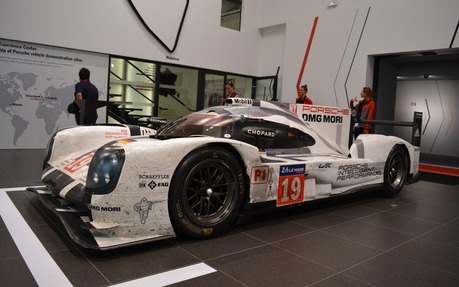Porsche’s Not-so-secret Weapon for Le Mans: The Two-time Winning 919 Hybrid
Race cars have long since been test beds for all kinds of automotive-related technologies. From brakes to tires, engines and gearboxes, much of what we take for granted in our road cars were, at one point, developed for racing, and were fine-tuned for our use.
We owe much of our Toyota Prius’ and Porsche 911’s safety components to them as well. But what about energy efficiency? Fuel economy? Sustainable mobility, these fancy words that all OEMs are mentioning whenever they get the chance? If not all of it has originated from racing, it’s on the track where advancements are being fast-forwarded into the 21st Century.
A fuel-efficient race car? This is an overly simplified approach to the rules the FIA World Endurance Championship instilled for 2014. Long-distance motor racing was once about creating and testing tomorrow’s technologies and, at the moment, nothing’s higher on the list of priorities than efficiency.
The car manufacturers participating in LMP1 have developed a hybrid powertrain that relies on lithium-ion batteries. All have an energy recovery system and an electric motor at the front. At the driver’s whim, the stored electricity can be used to power the front wheels for extra traction. Where the cars differ is in the choice of engines that drive the rear wheels.
The Audi R18 uses a turbocharged, diesel 4.0L V6, while the Toyota TS050 relies on a twin-turbocharged, 2.4L petrol V6. In the name of efficiency, the Porsche 919 harbours a turbocharged 2.0L V4 engine. Is Porsche out of their collective mind? No.
The engine itself develops roughly 500 horsepower while the front electric motor provides a temporary boost of over 400 horsepower. Not convinced? Well, um, they won Le Mans in 2015, killed it in qualifying before the 2016 race even began and ultimately won again this year. Convinced now?
The 13.629-km-long Circuit de la Sarthe includes some portions, 9.2 km to be exact, of actual public country roads. This is where we find the very famous Mulsanne straight where the Porsche Le Mans Prototypes (LMP1) regularly flies by at over 320 km/h.
How can a four-cylinder hybrid achieve such numbers? Before I explain further, know that the 919 crushes the 0-100 km/h in 2.2 seconds. Impressed? How’s about a 0-200 km/h in only 4.8 seconds?
As we all know, weight is always the enemy. The 919’s monocoque chassis is made of carbon fibre with a honeycomb aluminum core. The car’s weight is a paltry 875 kg and this explains why normal laws of physics seem to not apply to this car.
The sequential seven-speed racing transmission uses a carbon-fibre reinforced clutch to send the power to the locking rear differential. The suspension is a multilink pushrod affair while the brakes are internally ventilated carbon-fibre discs all around.
The car is far more than the sum of its parts. The aerodynamics, the wheel and tire combo and the power make for a car (term used loosely) that is faster, more advanced and more exciting to watch doing its job than any modern F1 car. This is, of course, my opinion.
At wide-open throttle, the 919 fires by GT cars as though they were at a drive-in window, waiting for their order and LMP2s are disposed of as though passing a beige Corolla with a Lamborghini Huracán. Watching the passing actually occur, it is difficult to assimilate how monstrously powerful and fast the cars are. The noise generated in the process is a symphony of whistling, grunting and super-sharp gear changes. It’s far more audible that the R18, although the TS050 barks louder.
The 919’s design all about function. The quad-spot headlights are the only recognizable Porsche street car-related styling cue. Otherwise, it’s barely more than a metre off the ground and just short of two metres wide. I may possibly be biased against open-wheel cars, but an LMP1 car trumps any F1 car in the looks department. The 919 Hybrid’s hyper purposed shell is a complete turn-on, especially when sporting race scars, like the one Hans Stuck is leaning on in the gallery which happens to the 2015 winner.
At the recent 24 Hours of Le Mans race, the 919 Hybrid won after the leading Toyota TS050 quit, or nearly, on the last lap. Despite the heartbreak for Toyota, the Porsche turned out to be the tougher of the two cars, if not the fastest.
